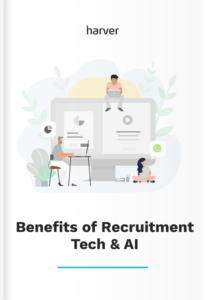Recruiters are the “people” people to help companies grow and thrive. You know, the ones responsible for putting the right individuals in the right roles. For this to work properly, your HR governance model needs to be clear and adapted to your organization.
There are multiple ways to structure the recruitment function in an organization. There’s really no right or wrong answer. The best recruitment model for your company depends on your current growth stage and plans for the future.
So let’s explore the three potential recruitment models: centralized, decentralized, and hybrid. Plus, we’ll highlight the advantages and disadvantages of each one.
What’s in?
What is centralized vs. decentralized staffing?
Choosing whether to staff your workforce via centralized recruiting, decentralized recruiting, or a hybrid approach is a challenging decision. Let’s define centralized vs. decentralized recruitment and how the models differ.
Centralized recruitment for staffing
In a centralized recruitment model, a single unit handles all hiring decisions and recruitment responsibilities. That means one corporate human resources (HR) department has sole decision-making authority with recruiting.
This centralized group is exclusively responsible for standardizing and overseeing the whole hiring process.
Decentralized recruitment for staffing
So what about a decentralized recruiting process? This means each manager or dedicated recruiter is solely responsible for recruitment decisions within their unit. For instance, they can choose their own employees based on different criteria.
Decentralized recruitment processes vary from unit to unit. They also allow for a lot of freedom in recruiting strategy. Additionally, some companies take a hybrid approach. In particular, some decisions and policies are deployed globally while others are local.
Like what you see?
Don’t miss out. Subscribe to our quarterly digest to get the latest TA and TM resources delivered right to your inbox.
Why and when should you centralize the recruiting function?
Today, about 50% of HR organizations have a centralized recruitment structure. Samsung operates with a centralized structure, which works well for the communications company. Why? Because it allows for extensive product development oversight at the corporate level.
Of course, centralizing your recruiting has both advantages and disadvantages.
Advantages of centralizing staffing
Centralized recruitment is popular among employers for a number of different reasons.
Operating with a centralized structure allows recruiting teams to develop consistent policies. It also enables universal standards for recruitment and hiring across the organization. Usually, that means the central HR department houses all of the valuable recruitment data. They can even use the same tech stack to operate as one recruitment powerhouse.
- For large corporations, a centralized process tends to be faster and more cost-effective.
- Centralizing responsibilities allows for better efficiency and lower costs overall. Specific employees can focus on recruitment, freeing up individual department leads to handle other responsibilities.
- A centralized recruitment function can also help ensure fair hiring practices.
- Standardizing recruiting requirements means every applicant has to follow the same process. As a result, the candidate experience is more likely to be fair and unbiased.
Disadvantages of centralizing staffing
Like anything, centralizing your recruitment function presents a few disadvantages as well.
- In most cases, there is a lack of flexibility when it comes to hiring and recruitment decisions. Especially if a change needs to happen fast due to something like high turnover.
- A centralized team often has a limited understanding of the unique needs of each business unit or local market.
- Unfortunately, this can result in the recruitment team making ill-fitting hires. For instance, by not understanding department staffing needs or mismanaging candidate expectations.
That’s why a centralized recruitment structure is often ineffective for more global organizations with localized hiring needs.
How AI & recruitment technology is changing recruiting experience
Find out how tech has helped other companies grow by enhancing both the recruiters’ and candidates’ experience!
Why and when to decentralize recruitment?
Only around 15% of organizations operate without any input or oversight from their corporate headquarters.
However, decentralizing the recruitment function makes sense for some employers. For example, Johnson & Johnson uses a decentralized recruiting function to suit their global structure.
On their website, here’s how Johnson & Johnson explains their decentralized approach:
“Each of our operating companies functions as its own small business. They are strongly entrepreneurial in character, and they know that their success depends on anticipating customers’ needs and delivering meaningful, high-quality solutions. While our people operate in a small company setting, they also have access to the know-how and resources of a Fortune 50 company. It’s like having dozens of strategic partners at their fingertips.”
Most retail companies also rely on a decentralized model. Let’s talk pros and cons to see if it makes sense for your organization.
Advantages of a decentralized recruitment process
With a decentralized recruiting process, policies can be tailored to unit or market needs and priorities. That means a decentralized process offers better recruiting flexibility. And that can lead to faster hiring, especially when you need to fill a position quickly.
Hiring managers benefit from firsthand knowledge of the working environment and departmental or local market needs. That personal touch can go a long way to making the right hires. It also empowers hiring managers with localized experience to operate independently of corporate headquarters.
Here’s how professor Carolyn Deller of University of Pennsylvania’s Wharton School of Business explained the pros and cons to each:
It can be difficult for HQs to understand the nuances of what is needed to serve customers of different demographics. Centralized hiring could be beneficial for employees to feel like they’re part of the organization. But the local managers’ informational advantage trumps any possible benefits of any centralized hiring.
– Carolyn Deller, University of Pennsylvania’s Wharton School of Business
Disadvantages of a decentralized recruitment process
Decentralized recruiting does have its disadvantages.
- For one thing, a lack of standardization across various business units. This can create a fragmented, disorganized hiring process with different recruitment standards and varying policies and pay grades.
- Plus, it’s hard for company leaders to ensure hiring practices are fair for every department and location. This can result in interviewer bias and prevent building inclusive teams.
In many cases, a decentralized recruiting function also results in really limited record-keeping. This is because there’s often not a sole database like an applicant tracking system used to track candidates. Typically, this also results in minimal recruitment data being stored. As such, that limits corporate visibility into different stages of the hiring process.
The best of both worlds: A hybrid recruitment structure
The remaining 35% of organizations have embraced a hybrid recruitment model. They operate with both a centralized and decentralized component. Recruiters are dispersed across various departments, but maintain a close relationship with the central recruitment function at headquarters.
Coca Cola is an example of a well-known organization that operates with a hybrid HR model. While their global headquarters retains overall decision-making, the corporation is divided into various regions. These geographic territories follow what some refer to as “decentralization within centralization,” or a hybrid model.
Subway is another company that gives local stores control over hiring for those specific markets. However, they also staff a centralized recruitment department to oversee the process and put universal standards and policies in place.
Advantages of a hybrid recruitment structure
A lot of successful companies are transitioning to hybrid recruiting models. A hybrid approach allows the central recruitment team to establish universal tools. It also enables universal policies and methods for recruiters to follow and standardize with training. This helps ensure fair and ethical hiring practices. Other benefits include centralized data collection and employer branding consistency.
At the same time, a hybrid model enables companies to also tailor local recruitment functions. For instance, addressing specific market needs as they come up. Plus, this can ensure a consistent and efficient recruitment strategy and process across the company.
Disadvantages of a hybrid recruitment structure
Does your organization have the right strategy and technology to support a hybrid approach? If not, coordinating your efforts between groups may be difficult. You need the right tools at your disposal.
Next steps for centralized vs decentralized staffing
Recruiting technology can help connect the dots in any of these recruitment models. That’s true whether your organization is choosing between centralized vs decentralized staffing.
With the right software at your fingertips, your organization can:
- Automate manual recruitment tasks to increase efficiency,
- House all applicants in a centralized database to avoid silos, and
- Track the right metrics for data-driven recruitment.
Want to see how Harver can support you in streamlining your high volume recruitment process? Book a demo below.
Ready to transform your hiring process?


